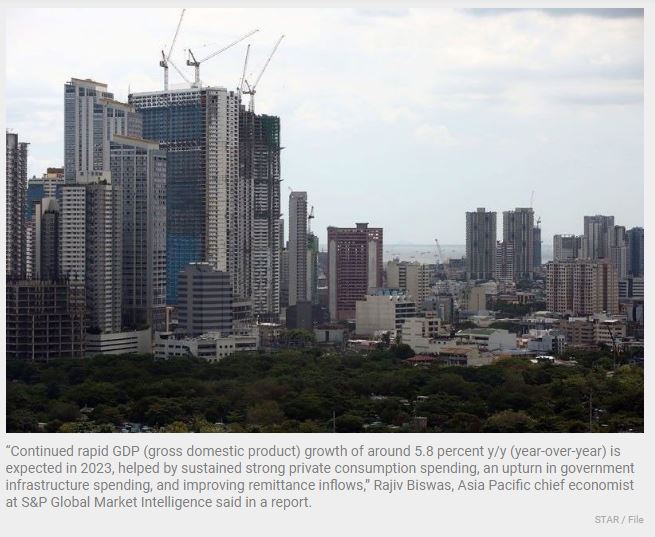S&P unit upgrades Philippine growth forecast
MANILA, Philippines — The Philippine economy may grow by 5.8 percent this year, faster than its earlier 5.6 percent projection, due to sustained consumption and amid expectations of a rebound in China’s growth, according to S&P Global Market Intelligence.
“Continued rapid GDP (gross domestic product) growth of around 5.8 percent y/y (year-over-year) is expected in 2023, helped by sustained strong private consumption spending, an upturn in government infrastructure spending, and improving remittance inflows,” Rajiv Biswas, Asia Pacific chief economist at S&P Global Market Intelligence said in a report.
While the 2023 GDP forecast has been upgraded from the 5.6 percent that S&P Global Market Intelligence provided in January, it is below the government’s six to seven percent growth target for this year.
The GDP forecast is also lower than the 7.6 percent growth posted in 2022, the fastest rate of expansion recorded by the country since 1976.
Biswas expects manufacturing to support growth this year, with the purchasing managers’ index reading of 52.7 in February showing expansionary conditions for manufacturing output and new orders despite slowing from January’s seven-month high of 53.5.
He also said overseas Filipino workers’ remittances, the growing information technology – business process outsourcing sector, and the recovery of the tourism sector are expected to support economic growth this year.
“The transmission effects from weaker growth in the US and Western Europe are a vulnerability for the Philippines’ export sector in 2023, but the rebound in economic growth in mainland China is expected to help to mitigate these effects,” he said.
The Philippines is likewise expected to benefit from its participation in the mega trade deal Regional Comprehensive Economic Partnership (RCEP), which provides favorable rules of origin treatment.
“This will help to attract foreign direct investment flows for a wide range of manufacturing and infrastructure projects into the RCEP member nations, particularly into low-cost manufacturing hubs such as the Philippines,” Biswas said.
He said high inflation, however, remains a key concern in the near-term.
The country’s headline inflation rate eased slightly to 8.6 percent in February from 8.7 percent in January, amid a slowdown in upticks of transport costs and prices of some food items.
Despite edging down from January, the latest inflation rate is still way above the three percent in February last year.
Over the next decade, Biswas said the Philippine economy is expected to continue growing rapidly, with total GDP to increase to $830 billion in 2031 from $400 billion in 2021, with consumption spending cited as a key growth driver.
He said the growth in the size of the Philippine economy is expected to drive per capita GDP to rise to $6,400 by 2031 from $3,500 in 2021.
He also said the Philippines is expected to become a $1-trillion economy and join the likes of mainland China, Japan, India, South Korea, Australia, Taiwan and Indonesia in the Asia Pacific’s grouping of the largest economies by 2034.
“This will help to underpin the growth of the Philippines domestic consumer market, catalyzing foreign and domestic investment into many sectors of the Philippines economy,” he said.
Source: https://www.philstar.com/business/2023/03/13/2251154/sp-unit-upgrades-philippine-growth-forecast


 Thailand
Thailand




